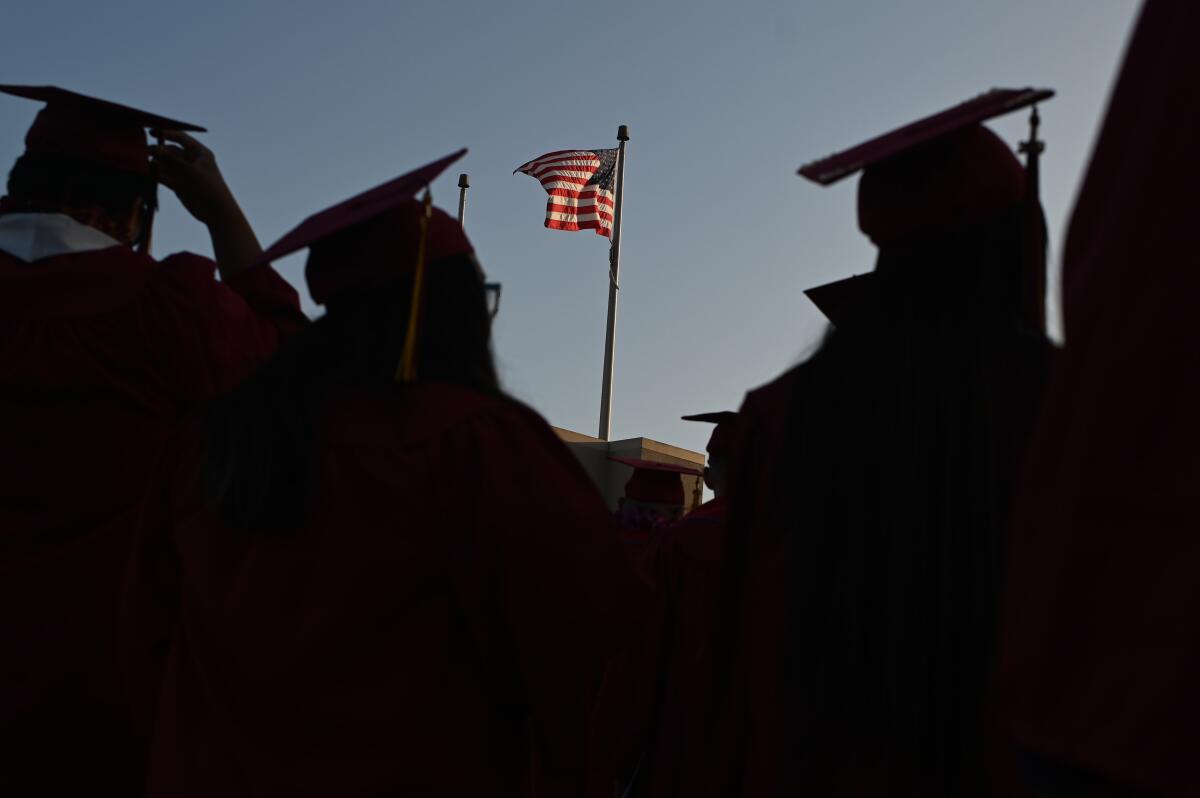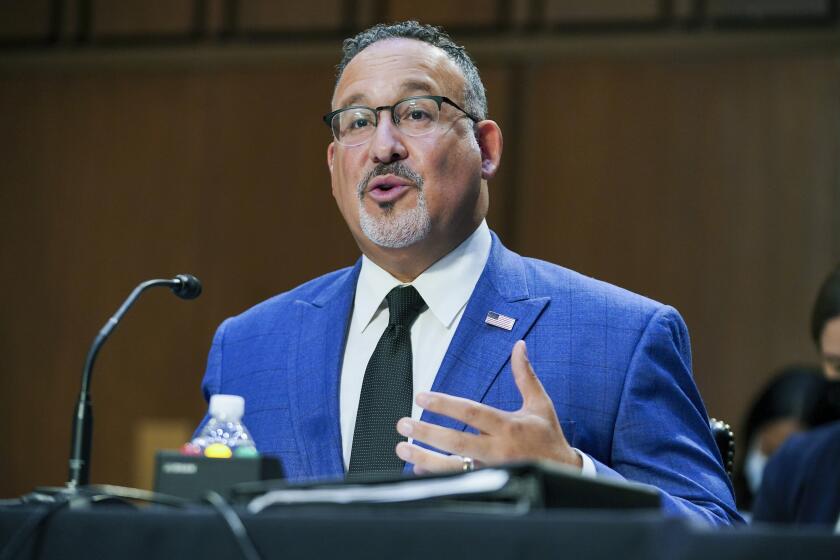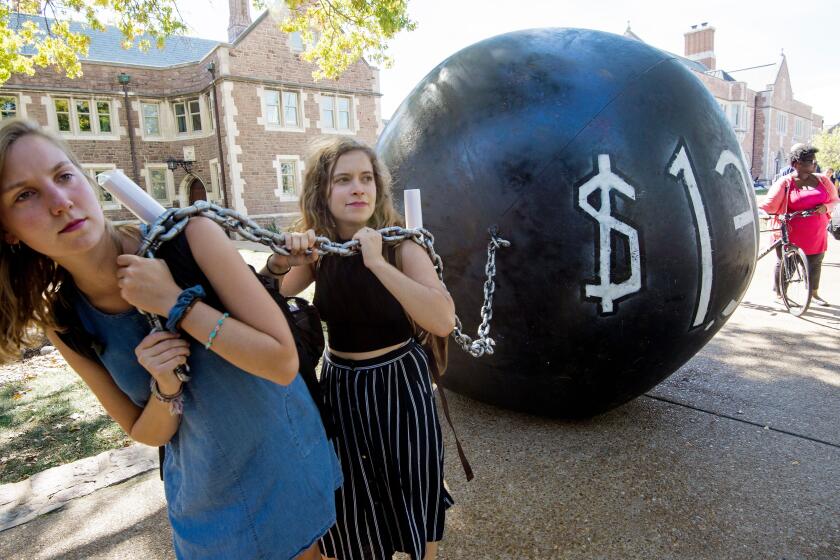What should student loan borrowers do while waiting for Supreme Court forgiveness ruling?

- Share via
If you have federal student loan debt, you may be waiting anxiously to see whether the Supreme Court will halt the massive loan forgiveness program the Biden administration announced last August. And if you listened online to Tuesday’s oral arguments, your anxiety level probably ratcheted up a few notches.
The justices heard arguments in two cases challenging the Education Department’s debt relief effort, which would erase up to $20,000 in federal student loans for low- and moderate-income borrowers. Two lower courts put the program on hold.
The court will decide two issues: whether the administration overstepped its authority, and whether the plaintiffs had the right to sue in the first place. A ruling is expected in a few months.
The Biden administration has extended its original pandemic-related freeze on payments and interest charges, which will end 60 days after the high court hands down its ruling.
What should you do now?
Financial experts say there are steps that you can take now to prepare for the aftermath of the court’s decision.
First, determine which company is servicing your federal loan or loans so you’ll know whom to pay if and when the time comes. Jaylon Herbin, director of federal campaigns for the Center for Responsible Lending, said there has been a lot of turnover among loan servicers in the nearly three years since borrowers were last required to make a payment.
If you owe more than the administration has proposed to forgive, as most borrowers do, your payment reprieve will end in a few months regardless of what the justices decide.
To find out who is servicing your loan, go to your account at the Federal Student Aid site (studentaid.gov) and call up the “My Loan Servicers” list.
Next, confirm how much you still owe, what your monthly payment will be and what the interest rates are on your loans. You can call your servicer to get its figures, or you can log into your account at studentaid.gov and check the numbers there. Make sure the record shows all the payments you’ve made. If it doesn’t, call your servicer and point out which payments are missing. And if that doesn’t fix the problem, file a complaint with the Education Department.
Start setting aside money now
Once you know what your monthly payment will be, Greg Ward, director of the financial wellness think tank at El Segundo-based Financial Finesse, recommended putting that much money into savings every month while waiting for the court’s decision.
“Pay yourself the same payment that you would have been making in your loans,” Ward said. “The idea is to get in the habit of living theoretically on less cash flow.”
By the time monthly loan payments resume, borrowers will have gone more than three years without that obligation. Putting the money into savings now will help you adjust your spending habits.
Ward saw no advantage to making voluntary payments before the mandatory ones resume — no interest is being charged during the payment pause, so lowering your balance won’t help on that front. Instead, he said, it makes sense to take the money you put into savings now, along with the interest it earns, and “make a lump-sum payment on whichever of your loans has the highest interest rate” once the government starts charging interest again, he said.
Consider a change in repayment plans
There are two basic ways to repay federal loans: plans that tie monthly payments to the size of your loan, and plans that tie monthly payments to your income, with the unpaid balance forgiven after a certain number of payments are made.
You can switch from one plan to another on studentaid.gov with no fees, but there can be a cost. Any unpaid interest will be “capitalized” — that is, folded into the balance of your loan, thus increasing the amount of interest you’ll accrue every month.
Nevertheless, there may be good reasons to switch. A standard plan with a 10-year repayment period could have a lower total cost than a 20- or 25-year repayment plan tied to your income, simply because the interest charged will be considerably lower. The monthly payments on the standard plan, though, would be higher — potentially much higher.
If you’re on a 10-year repayment plan and the looming resumption in payments seems unaffordable, there are a few options.
One is to switch to an extended payment plan that stretches your monthly payments out over 25 years. Another is to switch to an income-based Revised Pay As You Earn plan, whose terms are being upgraded substantially by the Biden administration.
Under a rule proposed last month, the monthly payments under these plans would be cut by more than half, meaning a much bigger amount would be forgiven after you’d made income-based payments for 20 years. (Some grad school or professional studies loans have a 25-year repayment option). Specifically, the amount would be lowered from 10% of your disposable income to 5%, and less income would be classified as disposable. In addition, forgiveness would kick in earlier for borrowers who took out smaller loans.
Be forewarned: The federal government will tax any amount of loan forgiveness received after Dec. 31, 2025. That’s a potential “tax bomb,” Ward said. The tax bill, however, probably would pale in comparison to the amount of debt discharged.
Will public service still erase loans?
The administration also has revised the Public Service Loan Forgiveness program, which promised to wipe out the federal student loan debt of people who make 10 years’ worth of payments while working in government offices, schools and other nonprofit jobs. The Education Department proposed a rule last year to expand eligibility significantly and give borrowers credit for many types of payments already made. UC Merced economist Charlie Eaton said the changes already made to the program on a temporary basis have canceled $21 billion in debt nationally.
Aoife Delargy Lowe, vice president of law school engagement and advocacy at Equal Justice Works, a public service law organization, urged borrowers with Federal Family Education Loans, Perkins loans or Health Education Assistance Loans to apply for a federal Direct Consolidation Loan by May 1 to take advantage of the changes in the program.
She added that the PSLF Coalition offers regular free webinars to educate employers and borrowers on how to successfully earn Public Service Loan Forgiveness.
With its plan for student debt relief on hold, the Biden administration is pressing ahead on a second front: Slashing monthly payments for more borrowers with relatively low incomes while holding down unpaid balances.
Preparing for the best-case scenario
If the justices allow the administration to go ahead and forgive debt, you may need to apply to receive the aid if you haven’t done so already. Some 26 million borrowers have submitted applications, and 16 million have been approved.
The relief will be extended only to borrowers with student loans issued by the federal government or, in the case of Perkins and FFEL loans, held by the Education Department. Any federal loan for which the monthly payments are still paused should qualify.
To check whether your Perkins or FFEL loans qualify, go to your account at studentaid.gov and look under the My Loan Servicers list; any name preceded by “DEPT OF ED” is a loan held by the federal government.
Also, eligibility is tied to your household income. The relief is only for borrowers who earned less than $125,000 a year or married couples earning less than $250,000.
The Education Department has said that it will enroll you automatically in the program if it has up-to-date information on your income to determine eligibility. Borrowers in income-driven repayment plans have to report their income annually.
Just say no to anyone offering to help you obtain the $10,000 to $20,000 in student loan debt forgiveness. You don’t need them.
If you’re in a standard plan, however, you’ll need to fill out an application form online, and there’s no way to do that at the moment. The department stopped accepting applications when a federal judge temporarily blocked the program. But you can sign up at studentaid.gov to be notified when the application will be available again.
What the debt relief will mean for you depends on the size of your balance and the type of repayment plan you’re in. Eaton estimated that the forgiveness would wipe out the balances owned by 16 million borrowers, or 40% of the total.
What if the court halts loan forgiveness?
The Education Department offers an online loan simulator to help you explore your options.
Ward of Financial Finesse said it’s also a good idea to talk to your employer about benefits that it might offer student-loan borrowers. Companies are starting to offer loan repayment assistance, he said, and a new federal law will allow employers to contribute the same amount to workers’ retirement accounts as workers pay for their student loans, starting in 2024.
“Employers recognize that this is something that affects a lot of workers, especially younger workers,” affecting their health and productivity, he said. The new benefits “are things that you certainly want to bring to their attention,” he added.
One other bit of advice Ward offered was to go over your options with a financial professional. If you have access to a financial coach, a student-loan counselor or other advisor, you should discuss your options with them and evaluate “where you are personally in terms of your career, family aspirations and other factors like that.”
More to Read
Sign up for Essential California
The most important California stories and recommendations in your inbox every morning.
You may occasionally receive promotional content from the Los Angeles Times.
















